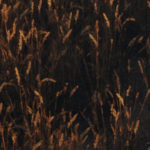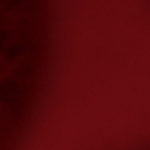Dorota Gawęda + Eglė Kulbokaitė
Collective Body ≠ Ego Death
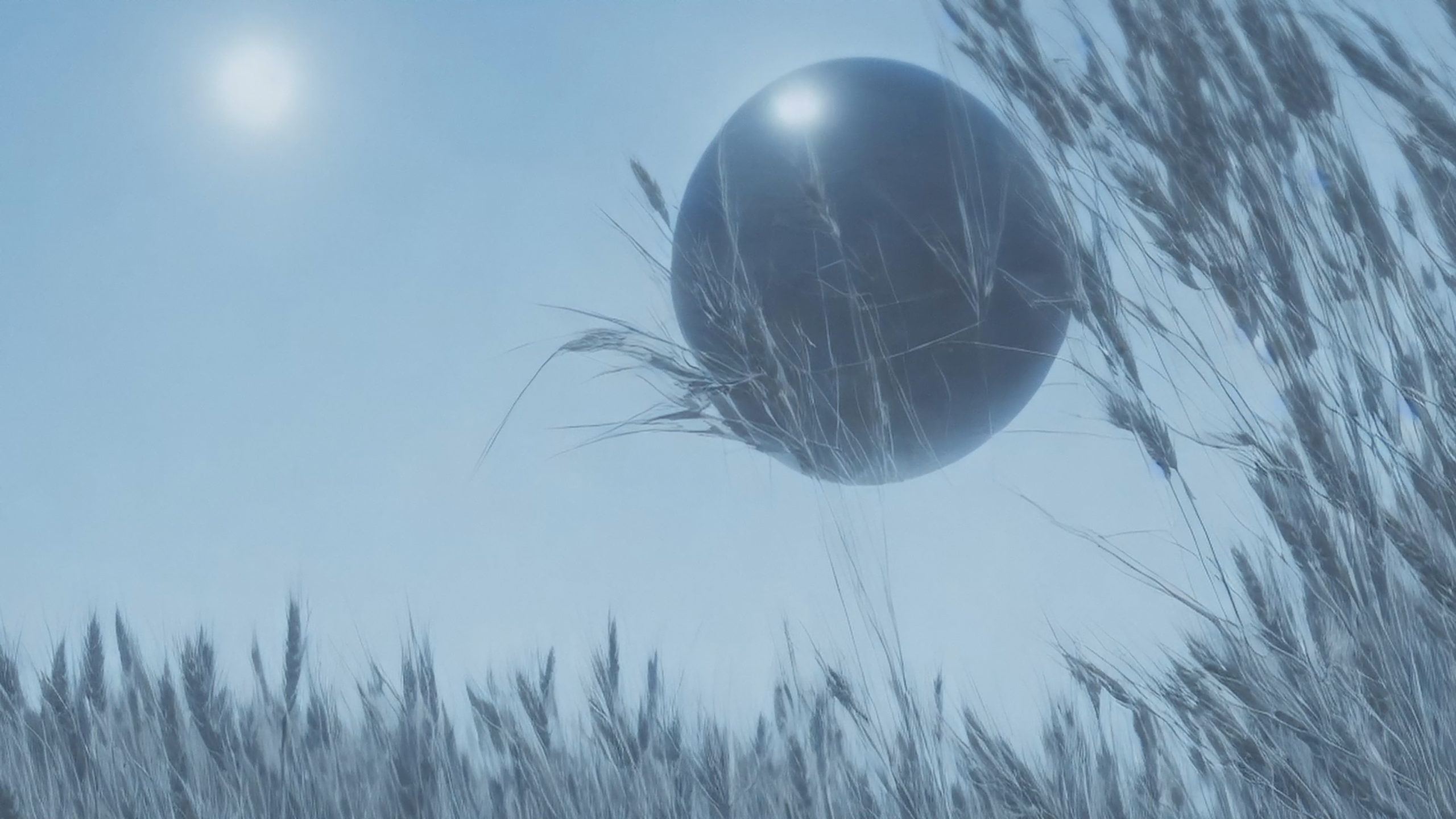
Dorota Gawęda and Eglė Kulbokaitė, film still from Mouthless Part III, two channel HD video, 2023.
We were speaking earlier about how transitional states can be generative. I think through the medium of film we can express the loss of fear of the unknown. It’s what we perhaps want to share most – that we might actually be able to live in a world where the unknown is accepted as something that we can interact with and learn from, instead of being sent into a dopamine-fueled panic.
An undead girl haunts fields of rye. Maybe girl is the wrong word – maybe it’s demon, witch, or both. Sometimes you think you see her when the sun finds its highest point in the sky: sweat bleeding into your eyes, you swear there’s a white cloak, a dust cloud, a scythe, writhing and whirling on the edge of the horizon. Sometimes you think she’s a hallucination. Sometimes you know she’s inside of you.
The Basel-based duo Dorota Gawęda and Eglė Kulbokaitė work in multiples across performance, painting, sculpture, fragrance, and video installation. You can find them where language breaks down and one genre or author morphs into many. Transfusing different bodies of knowledge across space and time, they nurture a research-based practice that weaves together seemingly disparate fields – ecology and technology, science and magic, nonhuman intelligence and shared speculation – into a collective carrier bag that’s always generating new offshoots.
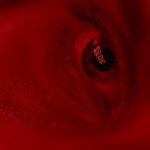
Dorota Gawęda and Eglė Kulbokaitė, film still from Mouthless Part III, two channel HD video, 2023.
“Our interest in theory comes from the Young Girl Reading Group project we organized for many years,” explain Gawęda and Kulbokaitė. “We wanted to find ways of reading together that would facilitate collectivity. We’d often read a theory text and follow it with sci-fi or articles; it created a way of flattening the hierarchies between different forms of writing. In this sense, a theory could be a chant or a spell; rather than instruct, it could serve as an active tool.”
Gawęda and Kulbokaitė initiated their collaborative practice after graduating from London’s Royal College of Art in 2012. Through Young Girl Reading Group (2013–2021), the duo built a non-hierarchical resource of hybrid readings, a Borgesian Library of Babel looped together by an infinite string of embodied narration. The project was conceived as a shared knowledge ecosystem that’s routinely activated and reshaped by group reading performances that levy affect, attention, attachment, and the political possibilities of listening-to, where full understanding of a text is always secondary to who is reading it and how it’s being read.
This preoccupation with slippery communication systems and their perpetual propensity for change continues to inform the duo’s chimeric practice, which has gone on to embrace multi-channel video, performance, scent, sculpture, and AI-generated imagery – often all at once.
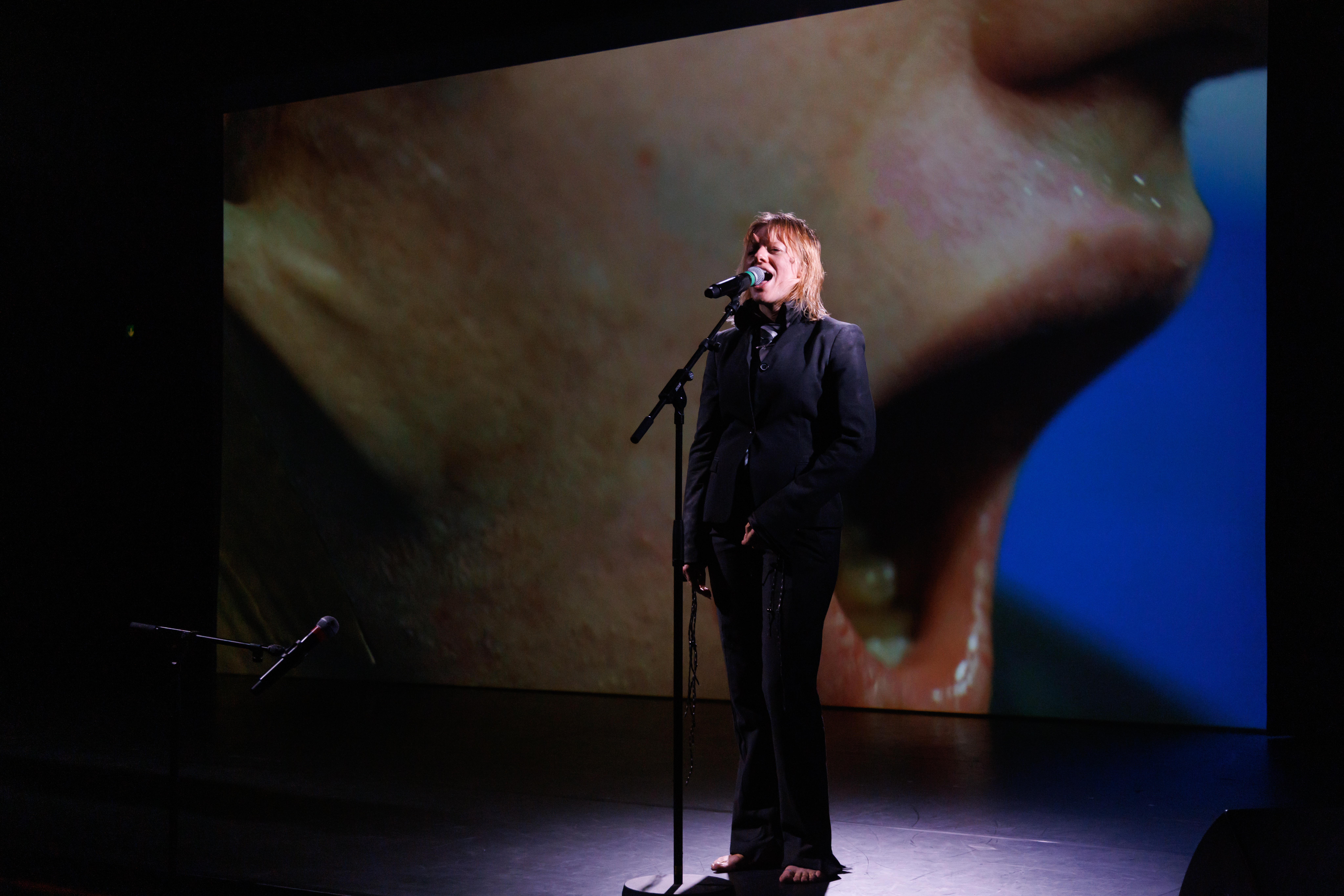
Dorota Gawęda and Eglė Kulbokaitė, performance documentation of Brood, Festival Move, Centre Pompidou, 2023. Photo: Herve Veronese.
Something I’d like to point to is the idea of embodied knowledge – the knowledge that comes from participation and experience, that’s not articulated with language, but arises through a process of the body being in the world, the relation to other bodies, the relation to that which is a similar experience of the world – these are things that might be expressed through non-linguistic systems, or non-visual systems.
A strong interest in folklore – how it weirds the relationship between body and landscape through storytelling, while opening up alternative states and temporalities through queerness and magic – runs through Gawęda and Kulbokaitė’s projects, particularly the ongoing multimedia trilogy Mouthless (2020–2023).
The series operates episodically, and while it manifests principally through video, it grafts onto the non-visual and non-linear, the machine-hallucinated, olfactory, and ritualistic, as a series of stories loosely tethered together by language, grief, the collective body, and ego death. Fact, fiction, theory, and folklore intertwine; these speculative stories are infused with scents, chants, and mythical characters.
“Folklore is a shared knowledge that’s available beyond certain classifications of bodies and time,” reflect the artists. “It’s a method of transmitting knowledge that’s not rigid or fixed; in that sense, it resembles the personal experience, a way of being in the world more closely.”
I do think we are connected on a deeper level than we realize. And I think folklore is a way of drawing those connections, drawing that web together.
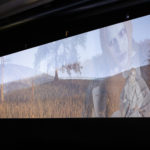
Dorota Gawęda and Eglė Kulbokaitė, “Mouthless Part III (Panorama)” at EPFL Pavilions, Pavilion A, Swiss Federal Institute of Technology, Lausanne, 2023. © Enter the Hyper-Scientific, EPFL. Photo: Riccardo Banfi.
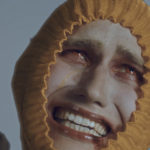
Dorota Gawęda and Eglė Kulbokaitė, film still from Mouthless Part III, two channel HD video, 2023.
Haunting these worlds are queer protagonists from Slavic and Baltic folk tales and traditions (stemming from the artists’ own backgrounds, Gawęda from Poland and Kulbokaitė from Lithuania) – interstitial bodies and spirits that occupy liminal, contaminated, edge-of-world zones: swamps, soils, spills. These characters are complicated and contradictory; their ethics opaque, their bodies nebulous – it’s difficult to tell where the monster ends and the human begins. For Gawęda and Kulbokaitė, that’s precisely the point. “Frequently one becomes the other,” reflect the artists. “This possibility of relating to the natural world, like the threat of always becoming the other, is very generative for us.”
I suppose there is an exchange of knowledge that happens through folklore – it’s not so much magic in terms of happily-ever-afters, but rather a perspective on the material world around us. You know, fairies and goblins. A sense of intrusion and uncanny.
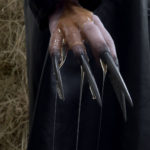
Dorota Gawęda and Eglė Kulbokaitė, film still from Mouthless Part I, single channel HD video, 2020.
Alongside folklore, Gawęda and Kulbokaitė tread the tense ground between nature and its artifice, particularly in the realms of synthetic biology and algorithmic image-making. In A Large Piece of Turf (2020), an industrial diffuser releases a drip-feed of synthetic petrichor – the pungent smell of water activating sleeping bacteria in soil, all rot and richness; the smell of life.
Mining the affective capacity of the most nostalgic sense, the artists point out an ambivalent truth: even if the signifier is fake, the influence of the signified remains true. This relationship is further pressurized in projects like Gusla (2020), a three-channel video work animated by LED fans, and the Mouthless trilogy, where algorithmically-induced images of the natural world are conjured up by a generative adversarial network (GAN), an AI model that pits two neural networks against each other to generate synthetic data.
“The ‘natural’ is a synthetic, manufactured concept,” suggest the artists. “We’ve been considering how artists participate in this construction throughout history and with emerging technologies, as well as our own position in this system.”
As the simulated landscapes writhe and morph into each other, convulsing in that sticky and hallucinogenic way that’s particular to GAN aesthetics, I’m reminded of Donna Haraway’s and Karen Barad’s ideas of entanglement – both the multispecies and quantum variety. Rather than manifesting in any particular image – any singular simulated tree branch, rolling hill, or apocalyptic sky – this understanding bubbles up through the flight pattern of the images. It’s folded into the feeling of a constant state of flux, a kind of weird, mutating ecology that, on the cusp of classification, always sneaks out the trap door – morphing into something else, somewhere else.
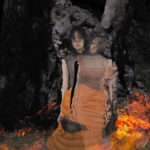
Dorota Gawęda and Eglė Kulbokaitė, film still from Mouthless Part I, two channel HD video, 2023.
We’re drawn to dormant knowledge that becomes suddenly visible or tangible through a new technology, rather than new invention. It’s not about opposing the classification of academic knowledge, but rather about interacting with it in a different way. Knowledge is fluid, not fixed in books. It’s always changing. This fluidity makes the difference between it being magic and not. It’s like some sort of energy that cannot be captured or explained in scientific terms.
Prominent theories in human evolution pin the birth of language at around 150,000 years ago, synchronized with the evolution of Homo sapiens, but what triggered this ability is less understood. The US ethnobotanist and mystic Terence McKenna suggested that both human consciousness and our capacity for language were catalyzed by repetitive low doses of psilocybin, absorbed into the proto-human bloodstream by a habit of consuming magic mushrooms. Lacking sufficient evidence, it’s little surprise that the scientific community has largely ghosted this theory.
But if language did develop through alternative states of consciousness, it’s perhaps the greatest irony that mind-bending experiences birthed the creation of a communication technology that has siloed our understanding of the world into only that which can be expressed through words. In their work, Gawęda and Kulbokaitė acknowledge the problematics of language as a way of reducing the world to a human-made system – closing down many possible realities in favor of a singular consensus reality. Put another way, when we learned language, what did we lose in the process?
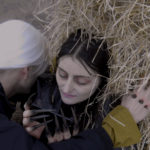
Dorota Gawęda and Eglė Kulbokaitė, film still from Mouthless Part I, single channel HD video, 2020.
“We are drawn to experiences that go beyond language,” reflect Gawęda and Kulbokaitė. “We tend to work a lot with sound, particularly polyphonic singing, where the idea of an individual body becomes irrelevant in favor of a collective body, a shared knowledge system.” It’s important to point out that Mouthless grew outwards from the spoken word, forming its visual cues like a soft shell over the murky abyss of contaminated language.
Across the three films, what is spoken and who is speaking fractures and slips away from each other as language breaks down and something else takes over. Glossolalia, the phenomenon of speaking in tongues, is teased out through the characters’ backwards reading of English in Mouthless Part II – an ecological lament in reverse that is sung over and over, with no clear boundaries among past, present, and future.
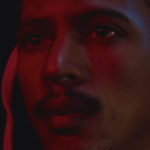
Dorota Gawęda and Eglė Kulbokaitė, film still from Mouthless Part II, single channel HD video, 2021.
In Mouthless Part II, the mourners want to transcend their grief, but they don’t have a ritual. In the process of mourning, there is this difficulty of allowing the process to occur, allowing it to go through the body, allowing it to come out. The way our brains seem to work, the way we learn about sadness or loss, it doesn’t go through all of your body. You’ve got these dead spaces in your body. It’s this bodily response where the body is aware of something but the brain is not.
You walk past a place, and you know that person who used to come there but you have no idea why. There’s a bodily awareness of that space, which you can’t associate with the abstract concept of knowledge. It’s almost like the spaces need to become aware of themselves and be able to come to terms with their own knowledge, in order to re-engage with the brain.

Dorota Gawęda and Eglė Kulbokaitė, film stills from Mouthless Part III, two channel HD video, 2023.
“There is a way of speaking which implicates your body in everything on earth,” suggests Daisy Hildyard in her essay, The Second Body, which makes a simple yet unnerving argument. Every living thing on this planet, Hildyard suggests, has two bodies: a physical body with tangible, sharp needs and expressions, and a global body – a kind of networked ecosystem – porous and leaking and inextricably involved with every other organism on earth.
Hildyard acknowledges the way that language has built artificial borders between life across scales: humans and animals, civilization and nature, the individual and the atmosphere. But when this kind of language is refuted, boundaries dissolve and hierarchies disappear. Historically, this evacuation has occurred at the edges of the inexpressible – horror, magic, folklore – where language becomes slippery, teetering over the edge of shared understanding. In other words, where language becomes a second body.
The other way that the mourners tried to transcend their grief was by looking at their landscape. And they realized the landscape doesn’t have a name. In a similar way to how they’ve already created this communal language where they’ve already created this collective sense of being, they were able to do that with the landscape by calling it by a different name. It’s just a way of giving those things a name so that the brain can access them. The thing about grief is that it’s the opposite – it feeds on what it knows. It feeds on what it can classify.
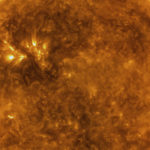
Dorota Gawęda and Eglė Kulbokaitė, film stills from Mouthless Part III, two channel HD video, 2023.
Drawing a conclusion to the Mouthless trilogy, Mouthless Part IIIc enters its narrative around the Południca, a mythical Slavic spirit who haunts field workers at high noon (mentioned at the beginning of this text). The film embraces a kind of quantum weirdness that confuses the boundaries between landscape and the body. Here the same actor plays both demon and human; the artists invoke the double-channel video format, coaxing a false binary just to dissolve it.
Pushing the confusion and generative capacities of mutation to their extreme, Gawęda and Kulbokaitė position the viewer as both witness and landscape, where even the intelligibility of landscape breaks down. Hallucinated fields of wheat rendered by AI models, layers of collaged effects and green-screen techniques blur the line between synthetic and real environments.
I think that in the shadow of the totalizing nature of the western scientific model, a lot of different homeopathic models, or additional knowledge systems outside of that Newtonian model, have been forced underground. Or completely eradicated. But I think that whenever the system gets overextended, that’s the moment when systems of resistance form. I’m thinking about the way that knowledge can be transmitted and can come back, can rediscover its voice.
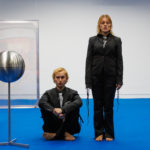
Dorota Gawęda and Eglė Kulbokaitė, performance documentation of Brood, Festival Move, Centre Pompidou, 2023. Photo: Herve Veronese.
BROOD (2023), set inside the duo’s architectural installation SULK (2023) at Centre Pompidou, doubles up as both a durational performance and live video stream. Borrowing from Lithuanian polyphonic singing traditions and the Gothic’s metaphorical use of body horror, its pair of performers haunt the institutional halls across a strung-out six hours, blurring binaries of normal-paranormal, victim-villain, and self-world. The protagonists’ prosthetic horns, permanently inserted AirPods and oversized black suits solicits a campy corporate demonism vibe; their disheveled excess melts the medicinal coolness of SULK, with its blue carpet, polished aluminum sculptures and transparent screens.
BROOD gives whiffs of Frankenstein’s monster – an adolescent hybrid caught within the oppressive framework of a knowledge experiment, longing to break out, despite their ignorance to the extreme state of the world Out There; the boundary between safe-house and container, between love and capture, stretches paper-thin and tears itself to shreds.
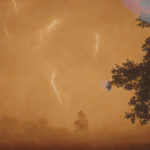
Dorota Gawęda and Eglė Kulbokaitė, film stills from Mouthless Part III, two channel HD video, 2023.
The summer that Shelley wrote Frankenstein coincided with an extreme weather event: a volcanic eruption in Indonesia turned the sky an acrid yellow for 100 days, conjuring the “year without summer” as temperatures plummeted into the negative centigrades in Europe while it snowed in New England. As wildfires blanket New York and Athens in a similarly jaundiced hue and global temperatures break their records, this time in the other direction, over two centuries later, one wonders whether BROOD is equally on the edge of something.
Within Dark Scenes from Damaged Earth: The Gothic Anthropocene, horror scholar Rune Graulund distinguishes between the affect of ‘horror’ vs. ‘terror’. Terror clams up the body, he suggests, freezing it in its tracks with fear, whereas ‘horror’ serves as a kind of existential opening, a turning toward the unknown. Applying additional pressure and sensation to this compulsion, new offshoots in weird fiction – a subgenre of speculative fiction that dislocates the human’s main character energy within the canon – amps up the latent desire to annihilate oneself (or any sense of self) within the death drive of the terror. Understanding this absolution as less an ending than an attuning to alternate states of being, Gawęda and Kulbokaitė’s works acknowledge a queer flourishing among a detonation of binary logic. Within their work, it becomes unclear who, exactly, is the monster, and that’s precisely the point.
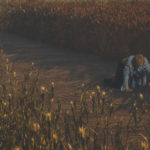
Dorota Gawęda and Eglė Kulbokaitė, film still from Mouthless Part III, two channel HD video, 2023.
Inspired by quantum theory, Gawęda and Kulbokaitė’s practice creates logical ruptures that scale, destabilizing the certainty of all knowledge systems. Their work opens a portal into possible futures that are more unruly and entangled; these are futures in which we are all implicated. “Quantum thinking is a way of stepping out of the binary,” the artists suggest. “It’s a challenge to the zeroes and ones of conventional processing, which has formed the background of human thinking. But there are no tools to approach a process that is done a different way.”
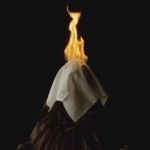
Dorota Gawęda and Eglė Kulbokaitė, film still from Mouthless Part II, single channel HD video, 2020.
Polyphonic singing allows superimposing of multiple voices in a way where they’re united. I think this is actually related to how quantum computers work… the idea of many voices dwelling together is maybe more true. Quantum physics is also related to communism in some way, which is this alternative paradigm to be explored.












